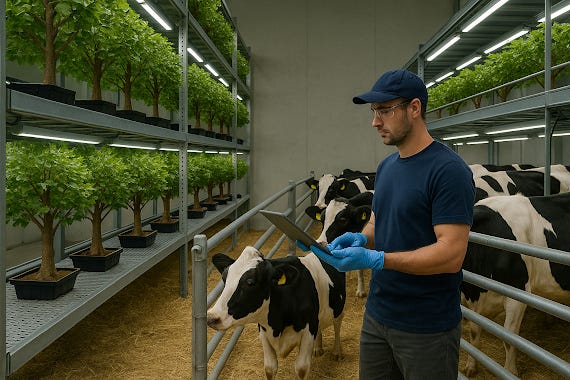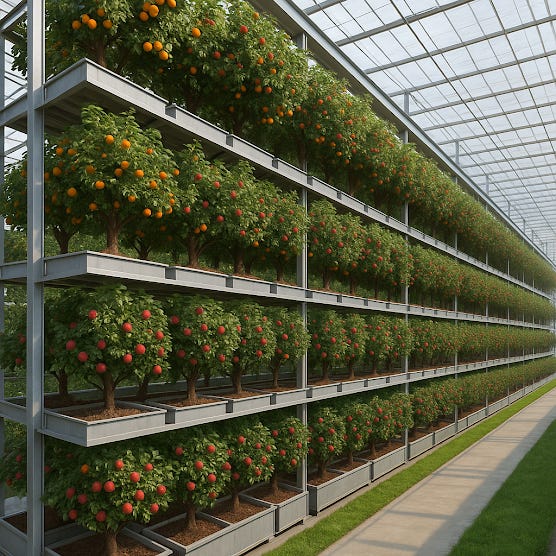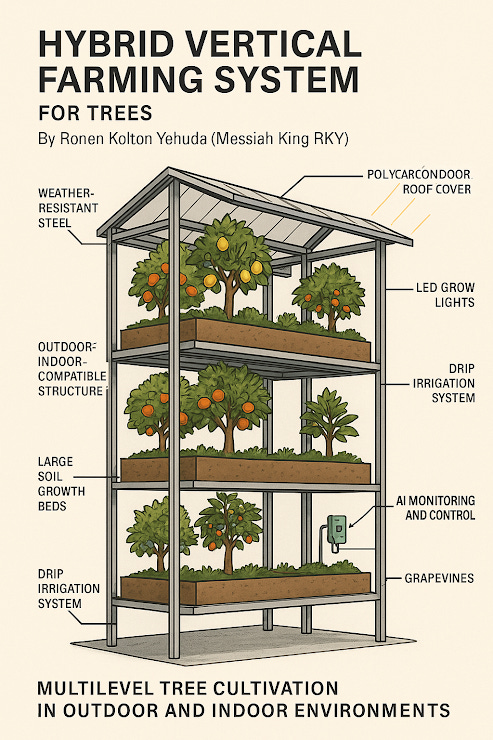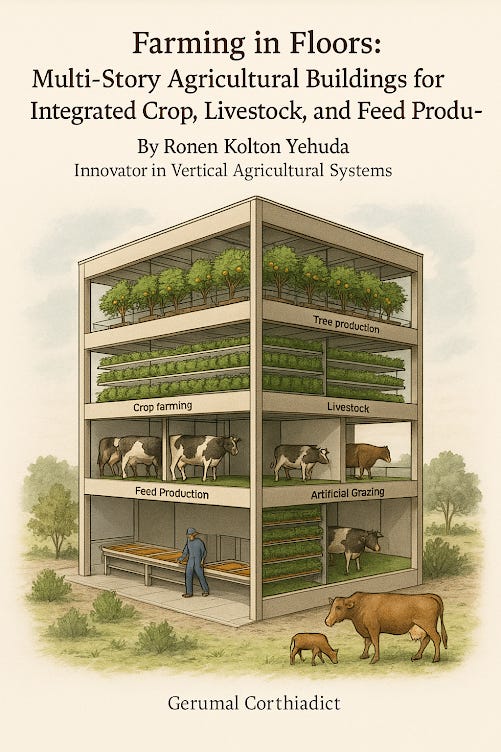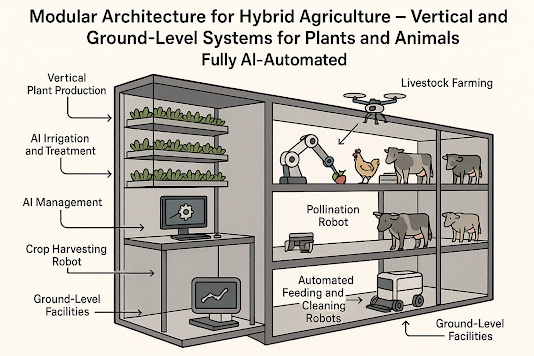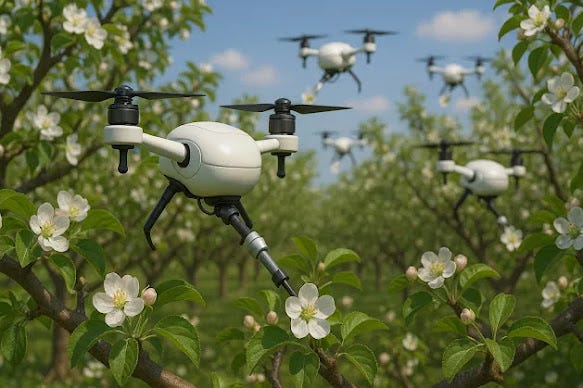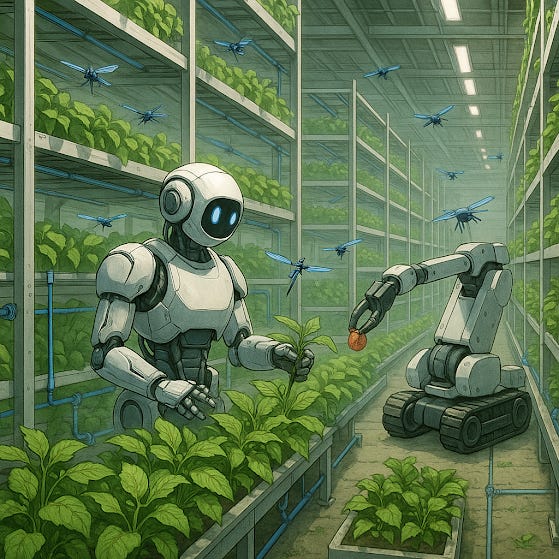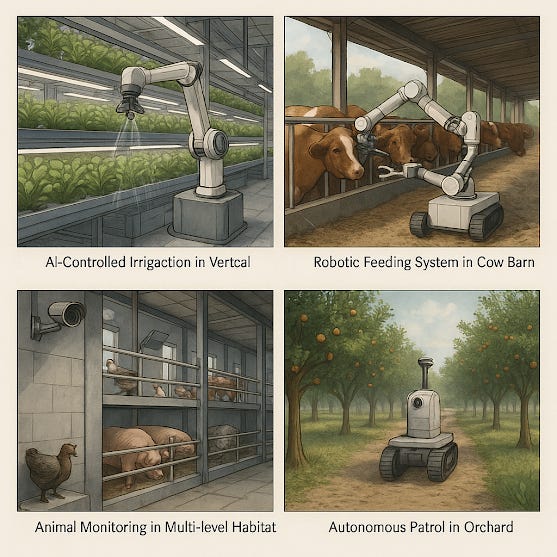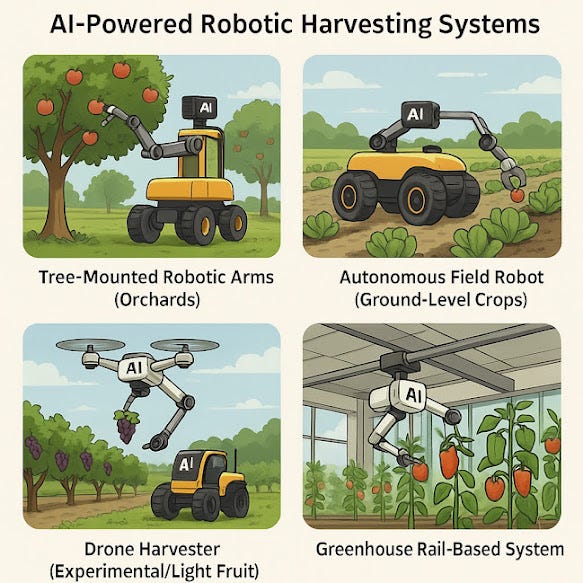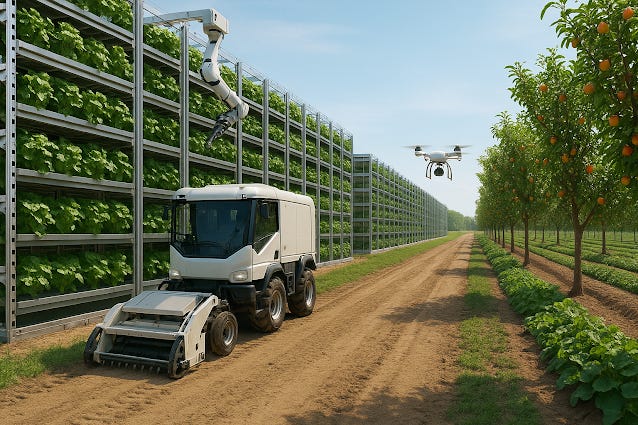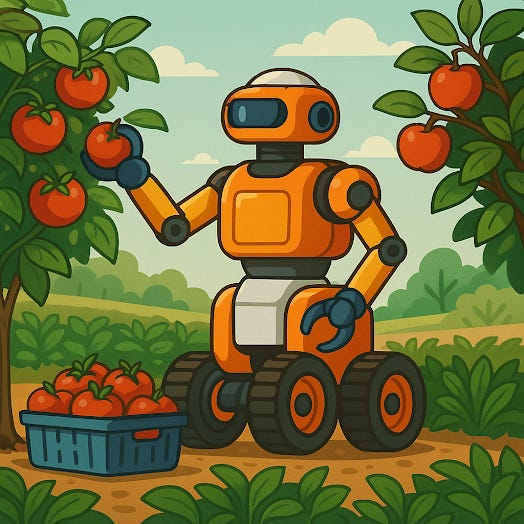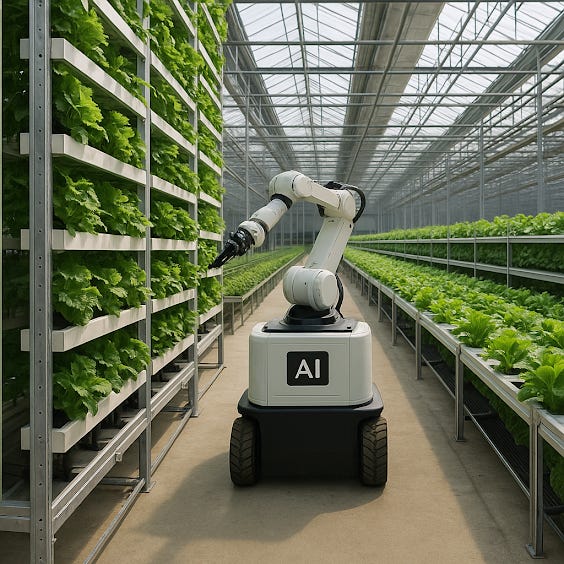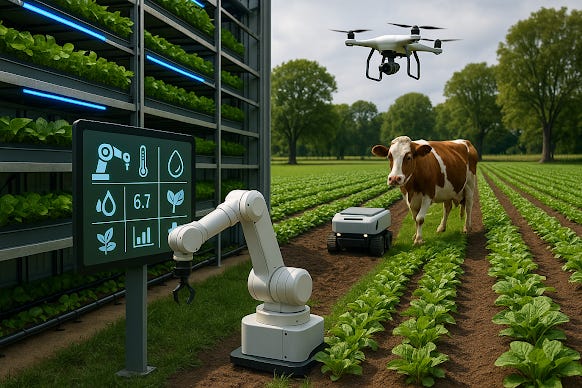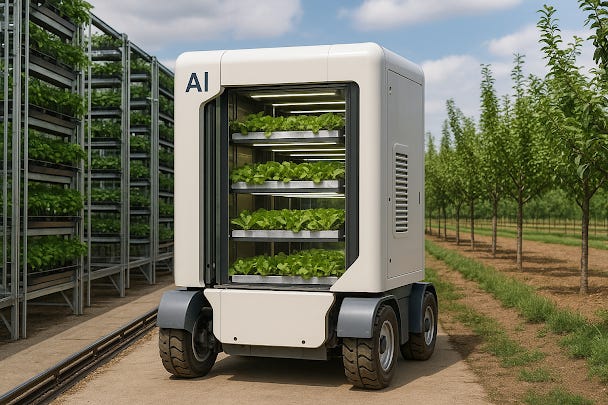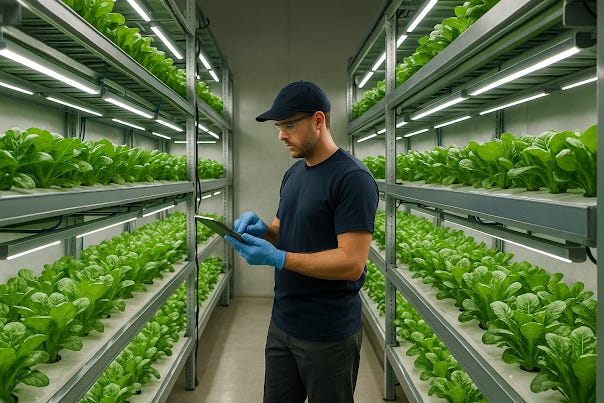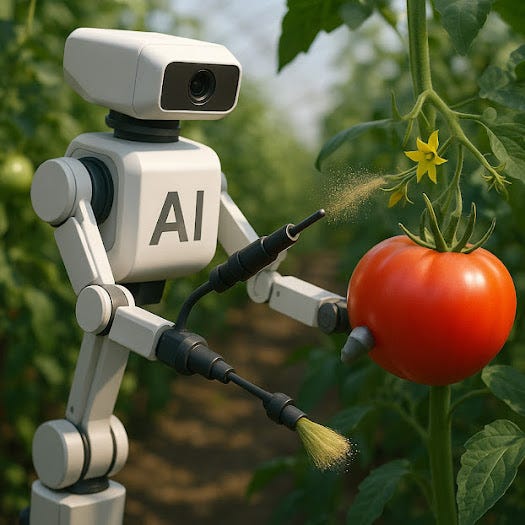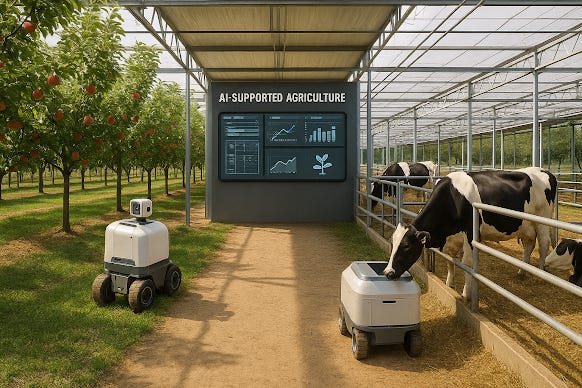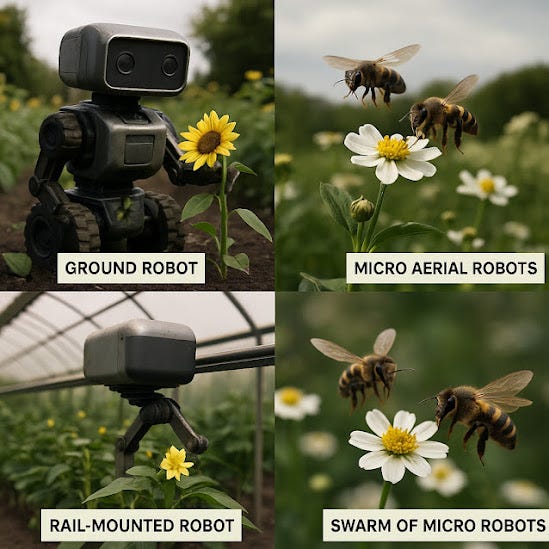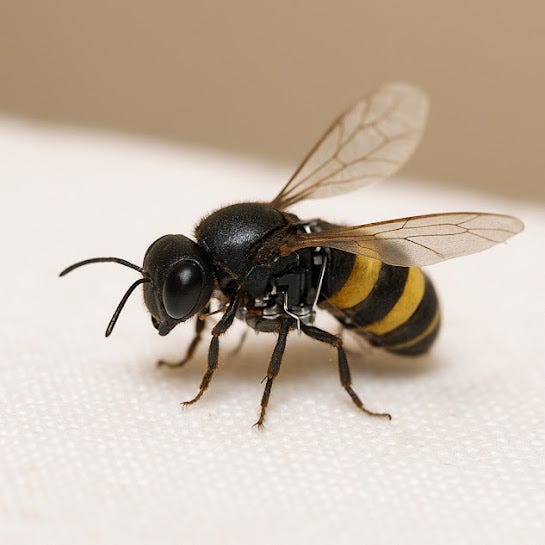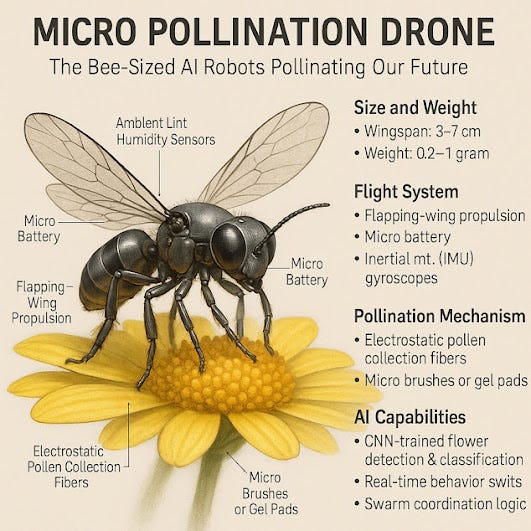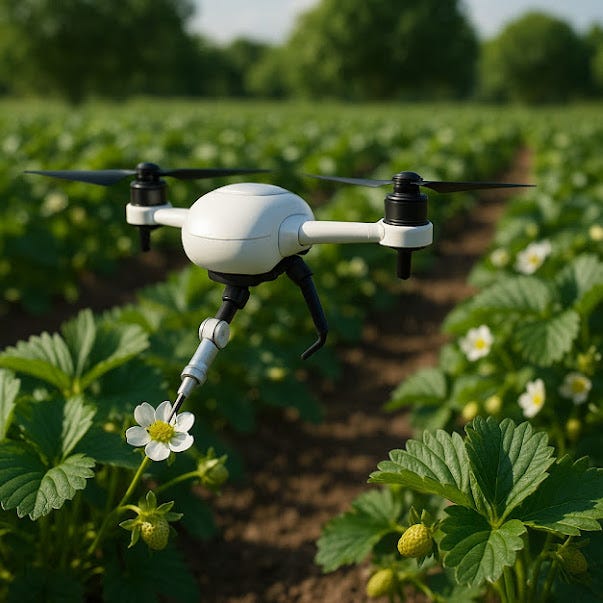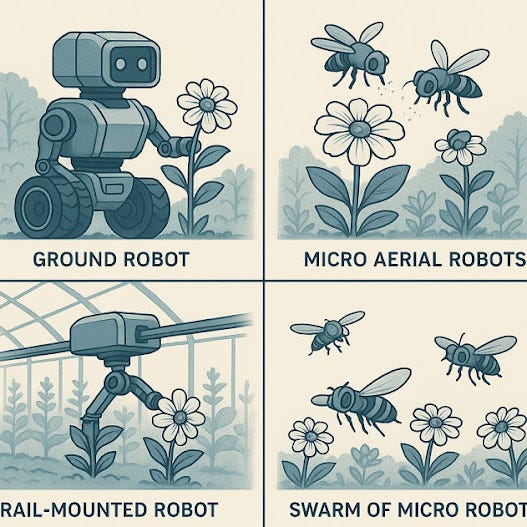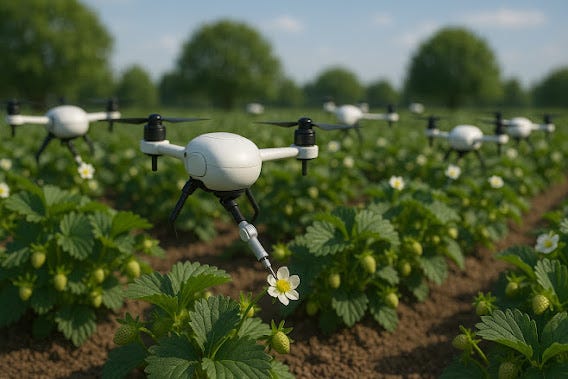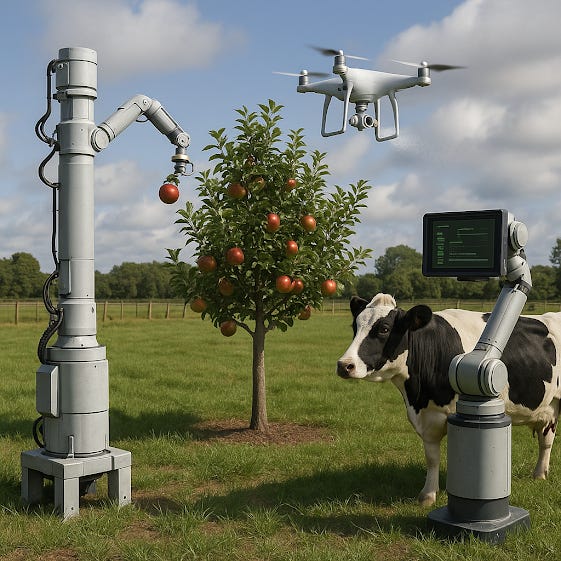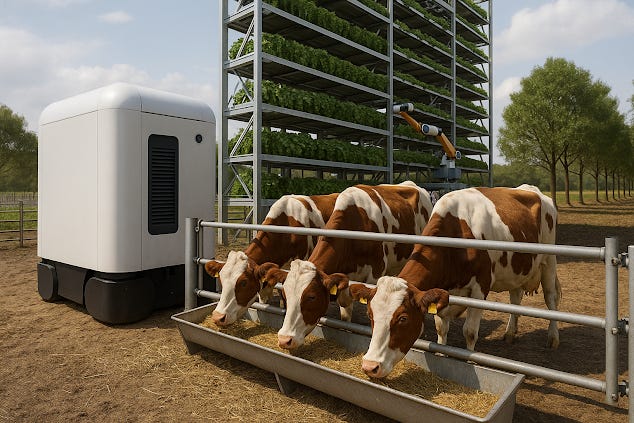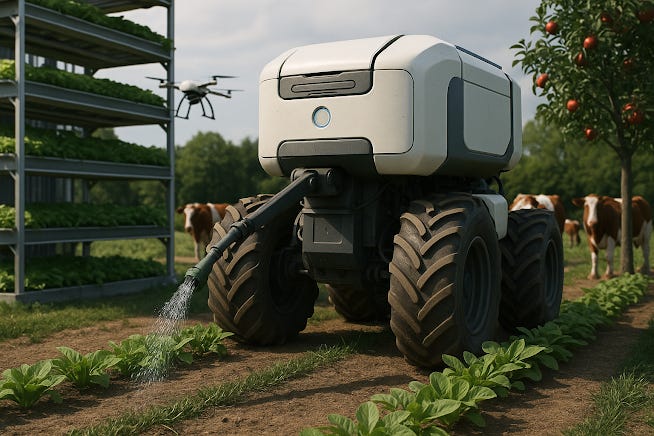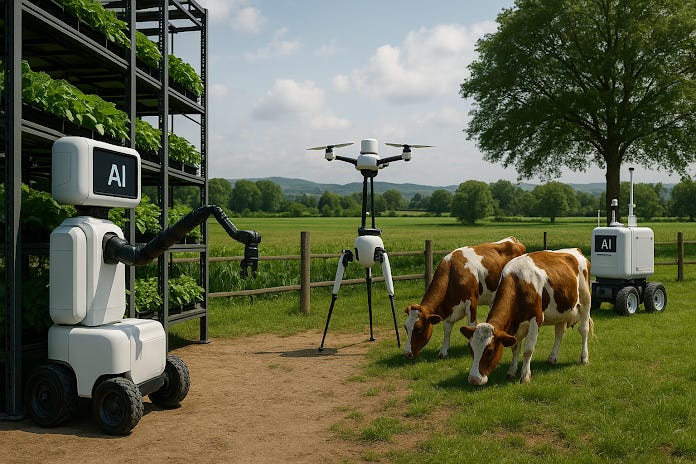Modular Architecture for Hybrid Agriculture – Vertical and Ground-Level Systems for Plants and Animals (Fully AI-Automated)
Modular Architecture for Hybrid Agriculture – Vertical and Ground-Level Systems for Plants and Animals (Fully AI-Automated)
Modular Architecture for Hybrid Agriculture – Vertical and Ground-Level Systems for Plants and Animals (Fully AI-Automated)
By Ronen Kolton Yehuda (Messiah King RKY)
As the global food system evolves, one principle leads the way: flexibility. The future of agriculture is not locked to one method, one terrain, or one form — it is hybrid, modular, and fully AI-automated, capable of adapting to urban towers, rural fields, disaster zones, or planetary colonies. Whether growing plants or raising animals, the infrastructure must support both vertical and ground-level deployment — intelligently managed by autonomous systems that operate without human labor.
This is the vision of hybrid modular agriculture: a universally adaptable architecture for fully automated farming — for plants and animals — designed to maximize yield, efficiency, and ethics in any environment.
🧱 Structural Foundation: One Modular Language
At the heart of this system is a unified modular design, a building-block approach to agriculture where each unit — plant bed, animal habitat, nutrient tank, or processing node — can be:
Stacked vertically or spread horizontally
Replicated, removed, or replaced independently
Assembled quickly in urban, rural, mobile, or underground settings
Plugged into AI-controlled lighting, feeding, watering, treatment, and harvesting systems
These modules can form:
Smart vertical towers with 10–50 floors
Ground-level smart barns and greenhouses
Rooftop farms or basement bio-chambers
Shipping container farms or emergency food bases
Integrated multi-species agro-industrial parks
🌿 Plant Agriculture Modules – Grow Up or Across
Each crop-growing unit is fully AI-managed and includes:
Hydroponic, aeroponic, or soil-based beds
Sensor arrays for root health, moisture, pH, nutrient uptake, and growth stage
LED light panels controlled by the AI for spectrum, duration, and intensity
Irrigation and fertigation lines delivering nutrients drop-by-drop based on real-time data
Climate regulation systems: CO₂, airflow, temperature, humidity, UV filtration
In Vertical Deployment:
Crop beds are stacked on multiple floors, each treated as a microclimate
Robotic arms maintain, harvest, and replant automatically
Pollinator drones operate between levels
Solar or grid power supports closed-loop lighting and water systems
In Ground-Level Deployment:
Beds extend horizontally in large halls or greenhouses
AI manages zones row-by-row
Smart tractors or rail-based bots operate across corridors
Outdoor hybrid zones use AI to adapt to real weather conditions
🐄 Animal Agriculture Modules – Intelligent Welfare in Any Shape
Fully AI-automated animal farming depends on detailed environmental control, welfare monitoring, and autonomous care systems. Each animal module includes:
Habitat pods sized per species (poultry, goats, rabbits, dairy cows, aquaculture)
Feeding stations with weight-sensitive, programmable dispensers
Watering systems with flow, purity, and consumption tracking
Smart floors for waste capture, robotic sweeping, and cleanliness tracking
Sensors for health, motion, noise, temperature, and stress levels
CCTV + thermal cameras for behavior and emergency detection
Sound and light modulation for behavioral enrichment and routine regulation
Vertical Livestock Towers:
Floors are dedicated by lifecycle: birthing, growth, production (milk/eggs), rest
Elevators or robotic lifts move supplies or animals (when needed)
Each floor is isolated to prevent contamination
Ideal for cities, where space is limited and biosecurity is critical
Ground-Level Animal Parks:
Long, low-density barns with AI-zoned corridors
Sectioned smart-paddocks or free-roaming enclosed gardens
Robotic cleaners and AI herding drones manage movement and cleanliness
Suitable for scalable, high-volume rural or peri-urban operations
♻️ Shared Systems Between Plants and Animals
In hybrid farms, plant and animal modules connect to create closed-loop ecosystems:
Animal waste is collected, treated, and converted into fertilizer or biogas
Crop waste becomes animal feed or compost
Water purification systems recycle from both systems
Waste heat from animals warms greenhouses
Insect farming modules convert waste into protein for animals or human consumption
Everything is tracked, optimized, and balanced by the central AI core.
🧠 AI-Centered Infrastructure Logic
What makes this system “fully AI-automated” is the coordination and autonomy of every component:
AI orchestrates irrigation, climate control, feeding, cleaning, harvesting, and animal health
Machine learning models adjust over time based on outcomes and environmental feedback
Predictive analytics prevent diseases, adjust planting schedules, and optimize yield
AI dashboards give human overseers full transparency — but no daily control is needed
The system can run 24/7 without supervision
If an anomaly is detected — whether a nutrient imbalance or an injured animal — the AI responds immediately: applying treatment, isolating units, or dispatching maintenance bots.
🛠 Maintenance and Expansion
The modular architecture allows:
Zero-downtime upgrades: swap a single unit without pausing the system
Scalability on demand: add floors, rows, or zones instantly
Cross-location deployment: replicate units between cities, countries, or disaster areas
Smart servicing: robots inspect and maintain equipment, flagged by predictive diagnostics
🌍 Where It Works
The system adapts to:
Skyscraper farms in dense cities
Smart barns and greenhouses on rural land
Rooftops, warehouses, or underground shelters
Floating structures, arid zones, or refugee settlements
Mobile units deployed in shipping containers
Each location chooses its layout — vertical, ground, or mixed — while the intelligence remains consistent across all.
🔄 Conclusion: Structure That Thinks
This hybrid architecture is not just a frame. It is a thinking infrastructure — built to host life, manage resources, and grow food without supervision. With AI as the central brain and modularity as the backbone, agriculture becomes intelligent by design — adaptable, autonomous, and regenerative.
Whether planted or raised, indoors or out, stacked or spread — food production is no longer constrained. It is fully automated, structurally free, and globally scalable.
Modular Architecture for Hybrid Agriculture – Vertical and Ground-Level Systems for Plants and Animals (Fully AI-Automated)
By Ronen Kolton Yehuda (Messiah King RKY)
Introduction
The future of agriculture is not linear. It is modular, autonomous, and hybrid — operating both vertically and horizontally, with full integration between plant and animal systems. In a time of climate instability, labor decline, urbanization, and global food insecurity, conventional farming models no longer suffice.
This article presents a comprehensive framework for a Fully AI-Automated Hybrid Agricultural Architecture. Designed to operate in any environment — urban, rural, or remote — the system houses both plant cultivation and animal husbandry across modular, stackable, or ground-deployed units. Every function is managed by intelligent systems: irrigation, feeding, climate control, health, harvesting, and reproduction.
This unified model enables ethical, efficient, and scalable food production — one that is deployable globally, regenerative by design, and prepared for the challenges of the 21st century.
The document is structured in five parts:
Part 1: Foundational Concepts of the Hybrid System
Part 2: Physical Infrastructure and Deployment Formats
Part 3: Daily Operation: AI-Controlled Care and Robotics
Part 4: Health, Ethics, and Reproduction Management
Part 5: Integration with Circular Systems and Global Applications
Part 1: Foundational Concepts of the Hybrid System
This system reimagines agriculture as an intelligent, modular infrastructure, capable of operating:
Vertically in multistory towers
Horizontally on rural lands
In greenhouses, rooftops, underground bunkers, or mobile containers
Whether cultivating vegetables or raising poultry, the architecture follows a unified logic: plug-and-play modules, fully autonomous and centrally coordinated by AI.
Core principles include:
Hybrid layout compatibility: deploy vertical or ground-level
Total AI-automation: 24/7 intelligent operation
Closed-loop integration: between plant, animal, water, and energy systems
Scalability and redundancy: units function independently or together
Ethical design: welfare monitoring, no confinement, environmental enrichment
Global flexibility: deployable in cities, deserts, floating farms, or disaster zones
Part 2: Physical Infrastructure and Deployment Formats
2.1 Modular Building Blocks
Each unit — plant bed, habitat pod, storage cell, or processing node — is:
Stackable vertically or deployable in rows
Interchangeable, transportable, and easily serviced
Connected via universal mechanical and digital ports
Climate-isolated for floor-by-floor or row-by-row zoning
2.2 Crop Architecture
Hydroponic, aeroponic, or soil trays with real-time root sensors
AI-managed LEDs, ventilation, and nutrient delivery
Robotic arms for planting, maintenance, and harvesting
Pollinator drones and smart irrigation nozzles
Vertical farms operate as climate-controlled towers. Ground-level farms use AI-managed greenhouses or horizontal beds.
2.3 Animal Infrastructure
Habitat pods based on species needs (e.g., goats, poultry, fish, rabbits)
Robotic feeders and auto-watering stations
Thermal and biometric sensors
Smart cleaning floors and sound/light modulation systems
Animal zones are arranged vertically (stacked floors) or horizontally (barns, paddocks), each AI-isolated for hygiene and control.
Part 3: Daily Operation – AI-Controlled Care and Robotics
3.1 Feeding and Hydration
AI adjusts feeding formulas per species, age, weight, and condition
Feed and water delivery is scheduled, weight-sensitive, and tracked per animal
Autonomous arms refill dispensers, clean containers, and calibrate dosing
3.2 Cleaning and Waste Management
Floor robots sweep, scrape, and vacuum waste into anaerobic digesters
Water misters disinfect surfaces
Air circulation is filtered, climate-tuned, and ammonia-monitored
All hygiene cycles are auto-triggered by contamination or time thresholds
3.3 Light, Air, and Behavioral Control
LEDs simulate natural day-night cycles
CO₂ and humidity sensors regulate air flow
Cameras detect restlessness, stress, or aggression
AI gates and light cues adjust zones and isolate animals when needed
Part 4: Health, Ethics, and Reproduction Management
4.1 Biometric Monitoring
Vitals tracked: skin temperature, motion, vocalization, posture, breath
Deviations trigger isolation and treatment
Full traceability is logged: from intake to output
4.2 Stress and Behavior
AI detects signs of stress and aggression
Sound and light modulation reduce tension
Enriched zones provide play and rest environments for animals
4.3 Reproductive Systems
Ovulation, fertility, and compatibility tracked
Mating, insemination, and birthing managed by AI with remote vet alerts
Animals rotate ethically, with lifecycle scoring and audit logs
Part 5: Integration with Circular Systems and Global Applications
5.1 Closed-Loop Systems
Waste-to-fertilizer or biogas conversion
Crop waste as feed or compost
Heat sharing between animal and plant zones
Water reuse between hydration and irrigation channels
5.2 Energy and Climate Adaptation
Compatible with solar, biogas, or grid power
Battery storage and smart scheduling
Designed for heatwaves, floods, and cold regions
5.3 Global Deployment Models
Urban towers with food independence
Rural smart barns with AI control
Emergency container farms for disaster zones
Floating farms or underground bunkers
Traceable, certifiable, ethical global export
Conclusion: Thinking Infrastructure for a Sustainable Food Future
This fully AI-automated, modular, hybrid agricultural system redefines what it means to farm. It is not a factory, but a self-operating ecological network — as responsive as it is resilient. Whether deployed in megacities or refugee camps, this system provides:
Consistent yield with reduced land, water, and labor
Ethical treatment through data-driven welfare control
Circular integration with energy, climate, and waste systems
Global compatibility across all ecosystems and economies
It is infrastructure that thinks, heals, feeds, and adapts — built to endure and regenerate, not exploit and exhaust.
This is not the automation of the old. It is the architecture of the next.
Part 1: Foundational Concepts of the Hybrid System
From the Series: Modular Architecture for Hybrid Agriculture – Vertical and Ground-Level Systems for Plants and Animals (Fully AI-Automated)
By Ronen Kolton Yehuda (Messiah King RKY)
1. Introduction
The global food system is entering a phase of structural transformation. Pressures such as population growth, land scarcity, climate volatility, rising ethical standards, and resource constraints demand a comprehensive redesign of how we produce both plant-based and animal-based food.
Conventional agriculture — whether in open fields or concentrated industrial barns — is inherently limited in adaptability, traceability, and efficiency. These legacy systems are spatially rigid, labor-dependent, and highly resource-intensive.
This first part outlines the foundational principles behind a new model: a modular, hybrid, and fully AI-automated agricultural infrastructure capable of growing crops and raising livestock in both vertical and horizontal formats, across any climate, geography, or emergency setting.
2. Hybrid Deployment Logic
The system is hybrid in two dimensions:
2.1 Structural Hybridization
Vertical deployment: High-density towers or multilevel structures in urban, industrial, or space-limited zones.
Ground-level deployment: Horizontal farms in rural, peri-urban, or remote environments.
Mixed deployments allow both crops and animals to coexist in hybrid agri-complexes — adapted to the needs of cities, islands, deserts, or shelters.
2.2 Cross-Species and Cross-Function Hybridization
Plant and animal systems share a unified modular infrastructure: growing beds, habitat pods, environmental control panels, and AI cores.
Modules are interchangeable, reconfigurable, and jointly orchestrated by a central AI.
Species-specific adjustments are implemented at the module level: light, air, water, feed, humidity, noise, rest, and harvesting.
3. Core Components of the System
3.1 Modular Infrastructure
Each agricultural function (e.g., feeding, growing, climate regulation) is hosted within a discrete, physically interchangeable module.
Modules are:
Plug-and-play: Compatible with unified connectors (data, energy, water, waste)
Scalable: Deploy one or thousands across locations
Redundant: Systems remain operational even if individual modules are replaced or repaired
3.2 Autonomous Operation via AI
Feeding, irrigation, harvesting, cleaning, climate control, animal health monitoring, and pollination are managed through AI algorithms.
No daily human presence is required — AI systems execute tasks, detect anomalies, and request assistance if needed.
AI models are trained on species-specific, crop-specific, and climate-specific parameters, adapting over time via machine learning.
4. Ethical and Functional Goals
4.1 Spatial Efficiency
Enables food production in dense urban areas, marginal lands, rooftops, or underground spaces.
Vertical farms reduce land use by up to 90% compared to field farming.
Ground-level smart barns reduce pasture demand and optimize logistics.
4.2 Climate and Resource Efficiency
Closed-loop energy, water, and nutrient systems minimize waste.
AI-adaptive lighting and airflow save energy.
Water is captured, purified, and reused.
4.3 Welfare and Transparency
Animals are housed in non-confinement enriched environments with biometric monitoring.
Crops grow in pesticide-free, sensor-controlled conditions.
Every process is traceable, auditable, and algorithmically accountable.
5. Applications and Environments
This architecture is designed for deployment in:
Urban agri-towers (dense cities, smart infrastructure projects)
Rural smart farms (large-scale animal and crop integration)
Climate-unstable zones (arid, flood-prone, or cold regions)
Emergency and refugee settings (containerized mobile farms)
Off-grid environments (military bases, island nations, or future space colonization)
Each unit may operate:
Independently (e.g., micro-farm or test site)
As part of a networked farm grid, coordinated by regional or global AI infrastructure
6. Strategic Implications
Food Sovereignty: Localized, vertically scalable production reduces reliance on imports and global supply chains.
Climate Adaptation: Operates resiliently in heat, cold, drought, or isolation.
Labor Transition: Relieves dependency on scarce agricultural labor.
Food Safety and Certification: Outputs meet high standards for hygiene, nutrition, and ethics — traceable from seed or birth to plate.
7. Conclusion
This hybrid, modular, AI-operated architecture is not an alternative to agriculture — it is its logical next stage. By allowing vertical and horizontal deployments for both crops and animals under fully autonomous control, it resolves fundamental bottlenecks in land use, ethics, productivity, and environmental impact.
In the sections to follow, we will detail how this infrastructure is physically designed, how its daily operations are executed, how welfare and health are monitored, and how it integrates into global food systems.
Part 2: Physical Infrastructure and Deployment Formats
From the Series: Modular Architecture for Hybrid Agriculture – Vertical and Ground-Level Systems for Plants and Animals (Fully AI-Automated)
By Ronen Kolton Yehuda (Messiah King RKY)
1. Introduction
The successful realization of a fully AI-automated hybrid agriculture system depends on a flexible, scalable, and environmentally adaptive physical infrastructure. The architecture must serve two simultaneous goals: maximize spatial efficiency through vertical stacking and ensure accessibility, scalability, and stability through ground-level deployment.
This part describes the technical foundation of the system’s modular structure — detailing how plant and animal environments are physically organized, controlled, and integrated. Whether in a city tower or rural field, the physical components remain consistent in logic and function.
2. Core Principles of Modular Design
2.1 Structural Modularity
Every unit — from plant bed to animal habitat to climate module — is designed as a standalone functional module.
Modules feature:
Standardized interfaces (power, water, data, waste lines)
Plug-in connectors for seamless expansion or substitution
Quick-deploy frameworks (no foundation needed for container systems)
2.2 Hybrid Configurability
Vertical Deployment: Stackable modules in multistory towers (10–50 floors), optimized for high-yield urban production or isolated compact sites.
Ground-Level Deployment: Horizontally arranged modular barns, greenhouses, aquaponic paddocks, or shipping container clusters.
3. Infrastructure for Plant Systems
3.1 Vertical Plant Deployment
Hydroponic and aeroponic beds are stacked in vertical racking systems.
Each floor or rack includes:
Sensor arrays (pH, nutrient levels, temperature, CO₂, light intensity)
AI-directed LEDs for precision spectrum and cycle control
Automated nutrient and water delivery
Robotic harvest arms
Air and water move through a looped circulation grid, monitored continuously.
3.2 Ground-Level Plant Layouts
Horizontal greenhouse arrays, optionally open to weather-adaptive AI panels.
Soil-based beds for specific crops, with robotic plows or micro-tractors.
AI manages zone-specific variables (light angle, airflow, drip rates).
Corridors support robotic logistics and mobile AI harvesters.
4. Infrastructure for Animal Systems
4.1 Vertical Animal Deployment
Modular animal floors are configured by lifecycle: birth, rearing, production (milk/egg), and rest.
Each floor contains:
Species-specific enclosures (e.g., goats, chickens, rabbits, aquaculture tanks)
Feeding and watering dispensers
Climate, waste, sound, and lighting control
CCTV and thermal behavior sensors
Automated cleaning systems (misters, floor scrapers, UV gates)
Elevators or lifts manage supply transport and animal access when necessary.
4.2 Ground-Level Animal Layouts
Large barns or low-density smart paddocks arranged in corridor-linked modules
AI-controlled ventilation, hydration, and feeding infrastructure
Movable fences or virtual zoning using sensory collars
Waste capture zones connected to biodigesters
Ideal for high-volume rural applications and regional cooperative farming
5. Shared and Cross-System Integration
5.1 Infrastructure Sharing
Waste recycling systems: Animal byproducts fertilize crop beds or fuel biogas generators
Shared climate systems: Waste heat from animals warms nearby crops
Water reuse: Purified water loops between systems, minimizing draw
Nutrient and light feedback: AI balances plant and animal rhythms for energy efficiency
5.2 Operational Consistency
Regardless of layout:
Sensor logic is standardized (data formats, thresholds, calibration)
AI protocols are interoperable across plant and animal units
Servicing is modular: Any module can be repaired, replaced, or upgraded without systemic downtime
6. Maintenance, Expansion, and Transportability
All modules are designed with:
Self-cleaning surfaces
Predictive maintenance AI agents
Redundant data storage and local controllers
Modules can be:
Re-deployed to new sites
Shipped in ISO containers
Expanded vertically or horizontally without redesign
7. Applications by Setting
Setting Deployment Format Output Focus
Urban rooftops Vertical/lightweight Leafy greens, poultry, fish
Rural smart farms Horizontal modular barns Dairy, meat animals, soil crops
Conflict/disaster zones Containerized hybrid units Emergency food resilience
Arctic/desert locations Insulated vertical stack Indoor vegetables, aquaculture
Offshore/floating zones Waterproof container modules Fish, algae, waste treatment
8. Conclusion
The strength of this agricultural model lies in its architectural neutrality and modular consistency. Whether stacked in dense cities or distributed across open land, the system functions identically at the operational level.
It supports rapid deployment, continuous scalability, and physical redundancy. Most critically, it makes no structural distinction between plants and animals — they are managed within the same logic framework, by the same intelligent core, with the same sustainability principles.
Next, we explore how this infrastructure operates on a daily basis: how machines, sensors, and algorithms deliver fully autonomous care — without dependency on human labor.
Part 3: Daily Operation – AI-Controlled Care and Robotics
From the Series: Modular Architecture for Hybrid Agriculture – Vertical and Ground-Level Systems for Plants and Animals (Fully AI-Automated)
By Ronen Kolton Yehuda (Messiah King RKY)
1. Introduction
The heart of any fully automated agricultural system lies not only in its structure, but in its capacity to perform and sustain complex daily operations without human intervention. Feeding, hydration, climate regulation, health monitoring, harvesting, cleaning, and behavioral modulation — all must occur in synchrony, governed by data and executed by machines.
This section details the daily operations of the hybrid system, orchestrated by AI and robotics, across both plant and animal modules. These systems work continuously, intelligently, and predictively — ensuring efficiency, sustainability, and biological well-being.
2. System Architecture and Control
2.1 Distributed AI Governance
Each module is embedded with:
Local microcontrollers and edge-computing units
Sensor arrays for specific functions (e.g., light, pH, weight, movement, humidity)
Communication relays to a central AI or cloud AI for macro-coordination
The AI governs all daily tasks based on:
Real-time sensor feedback
Behavioral modeling
Historical performance data
Environmental conditions
Operational priorities and yield optimization algorithms
3. Feeding and Hydration Systems
3.1 Animal Feeding
Robotic dispensers release precise rations based on species, age, weight, and health.
Multiple feed types (e.g., grain, hay, pellets, protein supplements) can be blended in real time.
AI tracks intake patterns to detect anomalies such as illness, stress, or crowding.
3.2 Plant Nutrition (Irrigation + Fertigation)
Nutrients are delivered in dissolved form via mist, drip, or circulation systems.
AI regulates:
Frequency
Dosage
Mineral composition
pH and EC levels
Excess water is captured, purified, and re-circulated.
3.3 Hydration Monitoring
Flow meters and quality sensors track consumption and purity.
Dosing can include vitamins, electrolytes, or probiotics as prescribed by AI models.
Alarms are triggered if hydration falls below safe thresholds.
4. Environmental Control Systems
4.1 Climate Regulation
Each module is a climate-isolated cell with controlled:
Temperature
Airflow
Humidity
CO₂ or ammonia concentration
Ventilation is adjusted continuously via actuators, fans, and filters.
4.2 Lighting and Circadian Management
Full-spectrum LEDs mimic day-night cycles based on:
Crop or species
Latitude
Behavior data
Light intensity, duration, and spectrum shift in real time to optimize growth or rest.
4.3 Sound and Behavioral Acoustics
AI listens for vocal distress, restlessness, or excessive silence.
Soothing or enriching soundscapes can be applied.
Noise levels are dynamically regulated to prevent chronic stress.
5. Movement, Activity, and Social Monitoring
Cameras and floor sensors map movement and interaction patterns.
In animals: pacing, lying, pecking, herding, or isolation patterns are analyzed.
In plants: growth curvature, leaf coloration, and posture are assessed via vision systems.
AI adjusts environments to:
Separate aggressive animals
Encourage natural rest/play cycles
Support optimal exposure to light or airflow for plants
6. Cleaning and Sanitation Automation
6.1 Animals
Floors cleaned via robotic scrapers, vacuums, and misters
Enclosures sanitized with non-toxic vapors or UV light
Bedding, manure, and spilled feed are collected and processed
Waste streams routed to anaerobic digesters or compost tanks
6.2 Crops
Plant zones flushed with clean water or mist
Pathogen detection via spectral analysis triggers microdisinfection
Trays or scaffolds are cleaned robotically during off-light cycles
7. Harvesting and Handling
7.1 Crops
Robotic arms with pressure-sensitive grippers harvest mature produce
AI selects harvest timing based on:
Growth curves
Nutrient analysis
Consumer preference (e.g., ripeness or starch level)
Sorting and packaging are executed on-site by conveyors and labeling bots
7.2 Animal Product Collection
Egg collection belts
Automated milking machines with real-time flow and quality sensors
Weight tracking for meat or wool production readiness
AI flags for rotation, fertility, or retirement based on performance history
8. Alerts and Oversight
Human managers receive alerts only in case of:
System malfunction
Emergency illness
Infrastructure breach
AI dashboards visualize:
Operational efficiency
Animal welfare score
Plant growth rate
Environmental resource usage
Manual intervention is rare, but always enabled.
9. Summary
In this architecture, daily agricultural activity is no longer a series of human-led routines. It is a perpetual, learning, self-balancing machine ecosystem, guided by algorithms that observe, evaluate, and act — all while preserving energy, water, and biological health.
Wherever food is produced using this system — in towers or fields, cities or deserts — the rules of operation remain identical. Only the geometry changes. Intelligence stays constant.
Part 4: Health, Ethics, and Reproduction Management
From the Series: Modular Architecture for Hybrid Agriculture – Vertical and Ground-Level Systems for Plants and Animals (Fully AI-Automated)
By Ronen Kolton Yehuda (Messiah King RKY)
1. Introduction
One of the most transformative aspects of AI-automated agriculture lies in its capacity to deliver continuous, data-driven care for living organisms — optimizing health outcomes, reducing suffering, and eliminating arbitrary handling. In this system, both animal and plant welfare are monitored, interpreted, and protected by algorithms trained on biological patterns, not economic shortcuts.
This section presents the architecture's ability to autonomously manage biometric health tracking, disease prediction, stress monitoring, and ethical lifecycle management — particularly for livestock — including reproduction, aging, and rotation. The system also provides complete traceability for audit, certification, or scientific oversight.
2. Biometric Identification and Continuous Monitoring
2.1 Animal Identification
Each animal is tagged using:
RFID implants, smart collars, or subcutaneous NFC
Facial recognition for larger mammals
Gait and behavior-based re-identification for small livestock (e.g., rabbits, poultry)
Each ID is linked to a real-time biometric profile, updated continuously
2.2 Vital Signs Monitoring
Sensor types include:
Infrared thermography (core temperature detection)
Sound mapping (respiration, vocal stress)
Posture sensors (limping, lying down too long, injury)
Feed and water consumption logs
Camera-based gait and microexpression recognition
The system builds individualized baselines for each animal, allowing the AI to detect anomalies before visible symptoms arise.
3. Predictive Health and Veterinary Logic
3.1 Early Illness Detection
When deviations exceed thresholds:
The animal is automatically segregated via robotic gates
Ambient conditions are adjusted (heat, airflow, noise)
AI generates a probability diagnosis
Human overseers receive a full behavior and vitals log
This proactive approach reduces mortality, prevents spread, and eliminates guesswork.
3.2 Disease Prevention and Immunization
The system:
Tracks immunization schedules
Adjusts microdosing based on immune response
Manages isolation chambers and reintroduction logic
Performs environmental decontamination as required
4. Stress and Behavioral Health Systems
Animals often exhibit signs of stress that precede visible health effects. The system uses behavior-based AI to manage comfort and enrichment.
4.1 Stress Signals
Detected via:
Vocal anomalies
Increased restlessness or stillness
Social aggression
Abnormal feeding or drinking rates
4.2 Responsive Adjustments
AI reacts by:
Adjusting lighting and soundscapes
Activating calming pheromone diffusers (if species-appropriate)
Separating individuals into rest pods
Increasing monitoring frequency
5. Reproductive and Lifecycle Control
5.1 Reproduction
Fertility is managed via:
Motion and hormone-response indicators
Ovulation and cycle predictions
Controlled mating or insemination timing
Birth environment preparation (heat, privacy, bedding)
AI automates:
Pairing schedules
Breed optimization (if permitted)
Postnatal care parameters
Litter tracking and growth milestones
5.2 Lifecycle and Rotation
Animals are rotated through stages (e.g., milk/egg production, resting, reproduction) based on biological signals, not fixed quotas
Retirement is flagged by the AI using:
Productivity decline
Reproductive fatigue
Health deterioration
The system maintains life history records and ethical flags for each animal, including euthanasia protocols (only if permitted by regulation)
6. Welfare Scoring and Transparency
Each module generates an ongoing welfare index composed of:
Health stability
Stress detection
Activity balance
Cleanliness metrics
Mortality avoidance
Growth and recovery rates
These scores are:
Logged in tamper-resistant databases
Auditable by third parties
Visualized for institutional dashboards
Optionally broadcast to transparency portals or certification agencies
7. Parallel Systems for Plant Health
Plants are monitored for:
Growth trajectory
Nutrient uptake efficiency
Leaf coloration and orientation
Disease or fungal spotting
Stress due to light, root density, or CO₂
Responses include:
Adjusting nutrient flow
Pruning via robotic arms
Redirecting light or airflow
Swapping beds or isolating rows for sterilization
8. Conclusion
The daily ethics of agriculture must move beyond reaction and regulation. With AI-powered biometric systems, ethical care becomes proactive, quantifiable, and standardizable.
Animals are no longer seen as anonymous assets — they are data-rich individuals whose wellbeing is embedded into the function of the architecture itself. Plants are treated as complex, living systems, not passive inputs.
This is not only a model of precision — it is a model of principled intelligence, scalable and exportable across all regions of the world.
Part 5: Integration, Circular Systems, and Global Applications
From the Series: Modular Architecture for Hybrid Agriculture – Vertical and Ground-Level Systems for Plants and Animals (Fully AI-Automated)
By Ronen Kolton Yehuda (Messiah King RKY)
1. Introduction
No agricultural system can claim to be sustainable without integrating resource efficiency, ethical logic, environmental circularity, and global adaptability. The final layer of the hybrid modular system is its integration with surrounding systems — water, energy, waste, logistics, and institutional networks — creating a model that is not only closed-loop but planet-ready.
This section presents how the architecture links plants and animals to one another and to broader infrastructure — forming a self-sustaining, data-integrated food ecosystem that is deployable in both developed and resource-constrained contexts.
2. Circular Resource Loops
2.1 Water Management
Water is cycled between:
Animal hydration and waste → filtration → irrigation
Plant evapotranspiration → condensation recovery → reuse
Surface cleaning systems → greywater separation → recirculation
AI ensures:
Clean vs. dirty stream distinction
Continuous micro-purification
Emergency storage control
Aquifer recharge and rain harvesting where applicable
2.2 Energy Recovery and Biogas
Manure, spoiled crops, and waste feed are funneled into anaerobic digesters
Methane is harvested for electricity and heating
Waste heat from livestock is redirected to nearby plant modules
Optional solar, wind, and battery layers provide resilience
3. Waste and Fertilizer Logic
Plant residues feed herbivorous animals
Animal waste is:
Separated (liquid vs. solid)
Converted into fertilizer
Measured and injected into plant systems through AI-dosed fertigation
Insect farming (e.g., black soldier flies) can convert both waste streams into protein or compost
Every output becomes another input — creating zero-waste loops with AI optimization.
4. Food System Integration
4.1 Traceable Output Streams
All plant and animal products are:
Digitally tagged (origin, date, growth metrics, care data)
Certifiable by blockchain or institutional audit
Stored with real-time location and welfare history
This enables:
Ethical labeling
Smart export management
Institutional supply chain integration (hospitals, military, education)
4.2 Local vs. Global Deployment
The same architecture can be:
Used in hyperlocal food sovereignty for cities or islands
Exported as containerized farms to remote populations
Scaled up for national food independence projects
Deployed as a backup food network for war, disaster, or space colonies
5. Application Environments
Environment Deployment Type Key Features
Dense urban centers Vertical towers or rooftop units Minimal land use, co-located with utilities
Rural/peri-urban zones Horizontal modular fields High-volume animal and crop output
Refugee or crisis areas Containerized mobile farms Emergency protein and crop generation
Islands or deserts Solar-hybrid, water-recovery farms High efficiency, closed water loop
Arctic zones Insulated vertical stacks Thermal control and nutrient cycling
Floating/offshore units Modular water-farms Aquaculture + desalination + solar energy
6. Institutional and Scientific Integration
AI dashboards can be shared with regulators, scientists, and oversight agencies
Ethical certifications (e.g., organic, cage-free, sustainable) can be granted based on real-time data
Universities and R&D centers can plug into live systems for continuous experimentation
Systems can connect to national food resilience grids and AI-enabled disaster response protocols
7. Global Ethical Impact
By eliminating:
Confinement farming
Open-loop pollution
Manual mistreatment
Genetic overloading and unnatural acceleration
...this model proposes a bioethically coherent food system — where AI serves life, and not the other way around.
Products grown in this system may:
Earn carbon credits
Carry premium ethical labeling
Qualify for climate grants or urban planning incentives
Become legal baselines for future agri-policy
8. Conclusion
The modular, hybrid, fully automated agricultural system is not an innovation in isolation — it is a convergent model that unites biology, computing, ethics, and sustainability under a single infrastructure.
By fusing vertical and horizontal formats, plant and animal systems, closed loops and open networks, this architecture offers a complete, climate-adaptable, and humane solution to the planetary food challenge.
It is not just agriculture for now — it is agriculture for everywhere, and for what comes next.
Fully AI-Automated Plant Agriculture System — Vertical Plant Growth on Multiple Levels
Hybrid Vertical Farming System: A Scalable Framework for Growing Trees, Crops, and…
____________________________________


